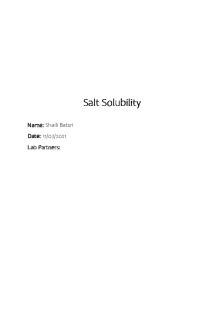Lab 7 Argentometry Volhard Method Determination salt in food DOCX

| Title | Lab 7 Argentometry Volhard Method Determination salt in food |
|---|---|
| Author | Nazira Mukhanbetova |
| Pages | 6 |
| File Size | 40.1 KB |
| File Type | DOCX |
| Total Views | 585 |
Summary
LABORATORY WORK Argentometry. Volhard’s Method Objective: Determination of table salt content in food by the argentometric titration. Titration is a process by which the concentration of an unknown substance in solution is determined by adding measured amounts of a standard solution that reacts wi...
Description
LABORATORY WORK Argentometry. Volhard's Method Objective: Determination of table salt content in food by the argentometric titration. Titration is a process by which the concentration of an unknown substance in solution is determined by adding measured amounts of a standard solution that reacts with the unknown. Then the concentration of the unknown can be calculated using the stoichiometry of the reaction and the number of moles of standard solution needed to reach the so called end point. Precipitation titrations are based upon reactions that yield ionic compounds of limited solubility. The most important precipitating reagent is silver nitrate. Titrimetric methods based upon silver nitrate are sometimes termed argentometric methods. The most popular are three methods from this group, named as their inventors: Mohr, Volhard, Fajans. All these methods use AgNO3 solution of known concentration, the Volhard one also solution of KSCN or NH4SCN. The sodium chloride content is determined by the well-known Volhard method. This method uses a back titration with 2 titrants like silver nitrate and potassium thiocyanate to determine the concentration of chloride ions in a solution. Before the titration an excess volume of a silver nitrate solution must be added first, followed by the concentrated HNO3, to the solution containing chloride ions, forming a precipitate of silver chloride. This order of addition is critical to ensure complete precipitation of the chlorides. The term 'excess' is used as the moles of silver nitrate added are known to exceed the moles of sodium chloride present in the sample so that all the chloride ions present will react. Ag+ (aq)+ Cl- (aq)--> AgCl(s) + Ag+ (excess) titrant analyte white ppt The indicator Fe3+ (ferric ion) is then added and the solution is titrated with the potassium thiocyanate solution. The titrate remains pale yellow as the excess (unreacted) silver ions react with the thiocyanate ions to form a silver thiocyanate precipitate. Ag+ (excess)+ SCN- (aq)--> AgSCN(s) titrant-2 Once all the silver ions have reacted, the slightest excess of thiocyanate reacts with Fe3+ to form a dark red complex: Fe3+ (aq)+ SCN- (aq)--> [FeSCN]2+ (aq) ind titrant-2 red complex The concentration of chloride ions is determined by subtracting the titration findings of the moles of silver ions that reacted with the thiocyanate from the total moles of silver nitrate added to the solution. This method is used when the pH of the solution after the sample has been prepared is acidic. If the pH is neutral or basic, Mohr's method or the gravimetric method should be used. The method is illustrated below by using the procedure to determine the concentration of chloride (from sodium chloride) in cheese. 1...
Similar Free PDFs

7 - Biomolecules in My Food Lab
- 4 Pages

Lab 7 - Food Webs
- 6 Pages

Food Delivery Refund method
- 1 Pages

Salt Solubility - Lab Report
- 4 Pages

Salt no. 7 ammonium sulphate
- 2 Pages

Lab 7 - Food Safety Spring 2020
- 9 Pages

Informe MOHR - Volhard
- 7 Pages

Boiling point determination lab
- 4 Pages
Popular Institutions
- Tinajero National High School - Annex
- Politeknik Caltex Riau
- Yokohama City University
- SGT University
- University of Al-Qadisiyah
- Divine Word College of Vigan
- Techniek College Rotterdam
- Universidade de Santiago
- Universiti Teknologi MARA Cawangan Johor Kampus Pasir Gudang
- Poltekkes Kemenkes Yogyakarta
- Baguio City National High School
- Colegio san marcos
- preparatoria uno
- Centro de Bachillerato Tecnológico Industrial y de Servicios No. 107
- Dalian Maritime University
- Quang Trung Secondary School
- Colegio Tecnológico en Informática
- Corporación Regional de Educación Superior
- Grupo CEDVA
- Dar Al Uloom University
- Centro de Estudios Preuniversitarios de la Universidad Nacional de Ingeniería
- 上智大学
- Aakash International School, Nuna Majara
- San Felipe Neri Catholic School
- Kang Chiao International School - New Taipei City
- Misamis Occidental National High School
- Institución Educativa Escuela Normal Juan Ladrilleros
- Kolehiyo ng Pantukan
- Batanes State College
- Instituto Continental
- Sekolah Menengah Kejuruan Kesehatan Kaltara (Tarakan)
- Colegio de La Inmaculada Concepcion - Cebu







